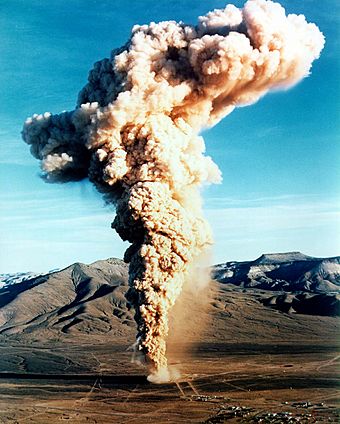Operation Emery facts for kids
Quick facts for kids Operation Emery |
|
|---|---|

Unexpected venting from the Baneberry nuclear test
|
|
| Information | |
| Country | United States |
| Test site |
|
| Period | 1970–1971 |
| Number of tests | 16 |
| Test type | underground shaft, tunnel |
| Max. yield | 220 kilotonnes of TNT (920 TJ) |
| Navigation | |
| Previous test series | Operation Mandrel |
| Next test series | Operation Grommet |
Operation Emery was a series of nuclear weapons tests carried out by the United States between 1970 and 1971. These tests were done underground to check how well nuclear weapons worked and to make them safer. They happened after a series called Operation Mandrel and before Operation Grommet.
What Was Operation Emery?
Operation Emery included 16 different nuclear tests. All of these tests took place deep underground at the Nevada Test Site in the United States. Scientists used shafts (deep holes) and tunnels to place the nuclear devices far below the surface. The main goal was to develop new weapons and to test their safety.
Underground Tests
Most of the tests in Operation Emery were designed to make sure nuclear weapons would work as planned. They also helped scientists understand how these powerful devices behaved underground. The largest explosion in this series was the Carpetbag test, which had a strength of 220 kilotons. To give you an idea, one kiloton is like exploding 1,000 tons of TNT!
The Baneberry Incident
One of the tests, named Baneberry, happened on December 18, 1970. Even though it was an underground test, some of the radioactive gases and dust escaped into the air. This is called "venting." The Baneberry test caused a large amount of radioactivity to be released, which was detected far away from the test site. This unexpected event led to a six-month break in nuclear testing at the Nevada Test Site while officials investigated what went wrong. It was a serious reminder of the risks involved in nuclear testing.

